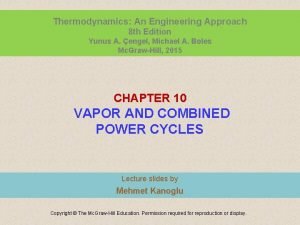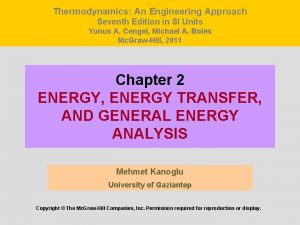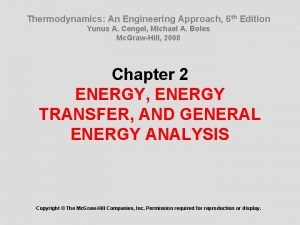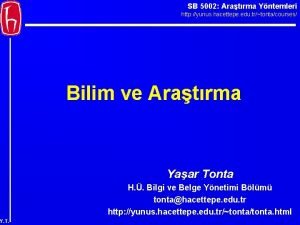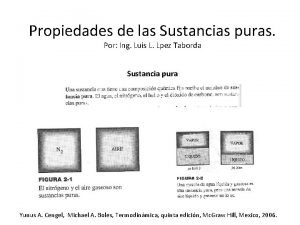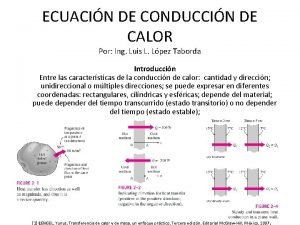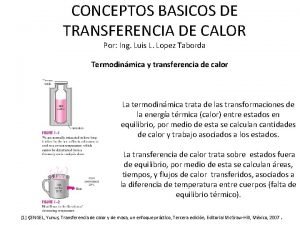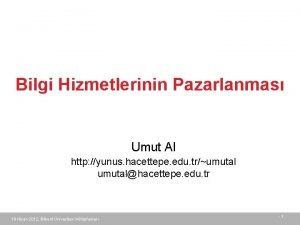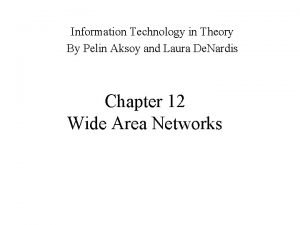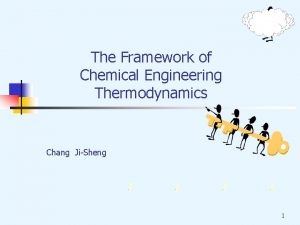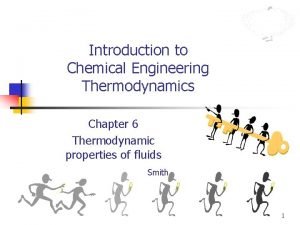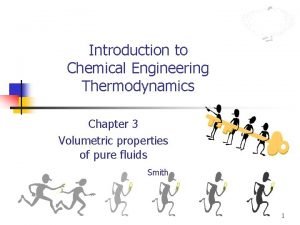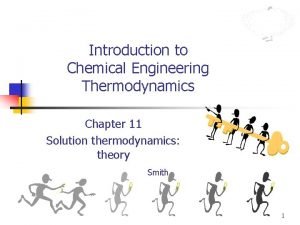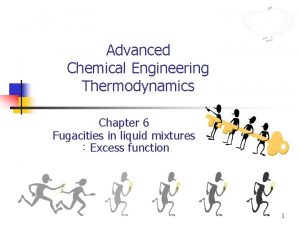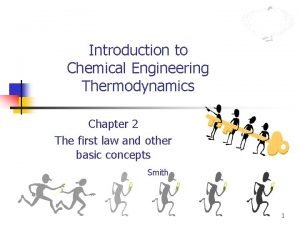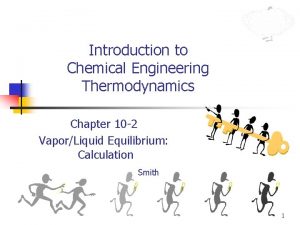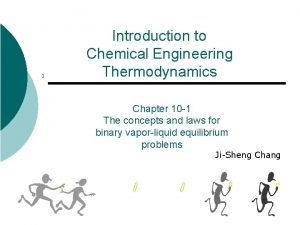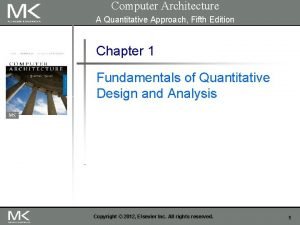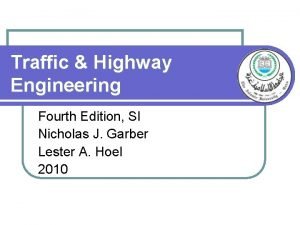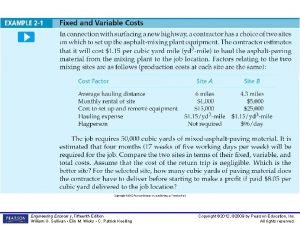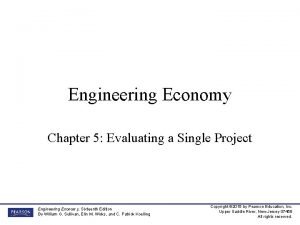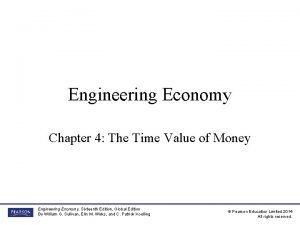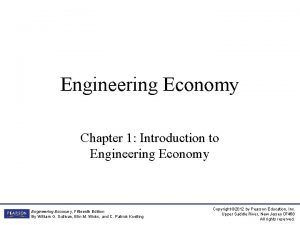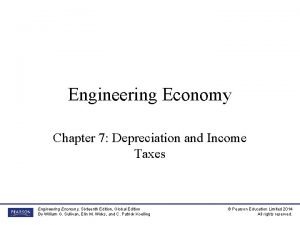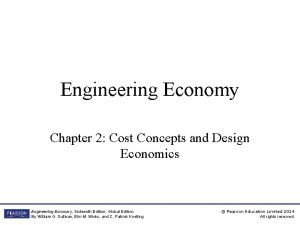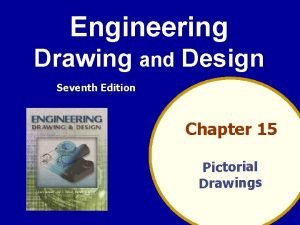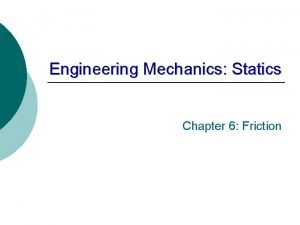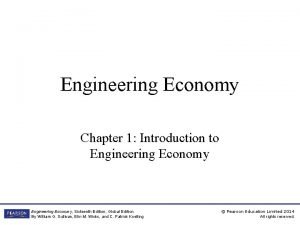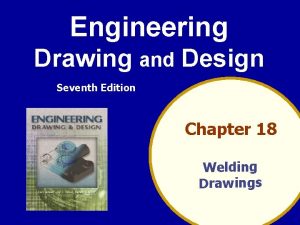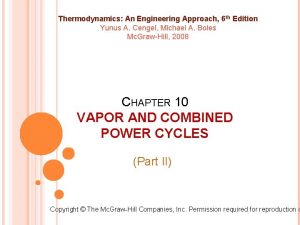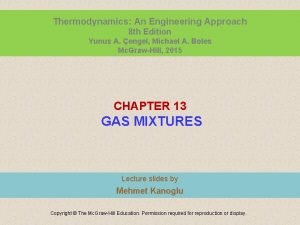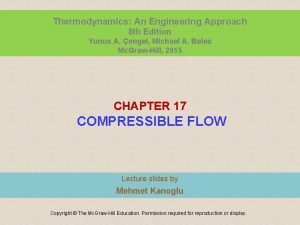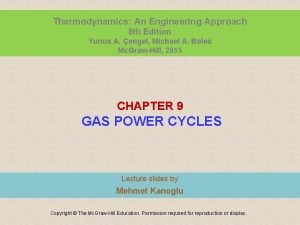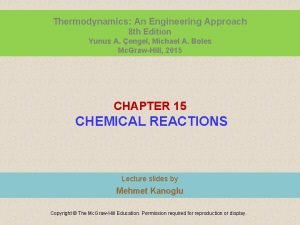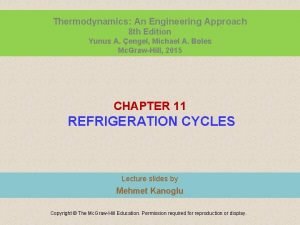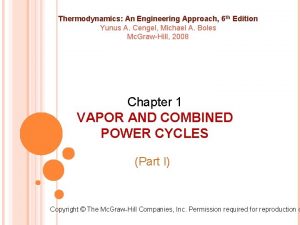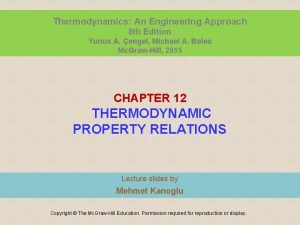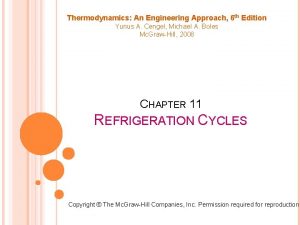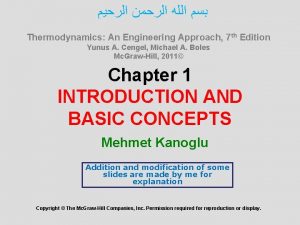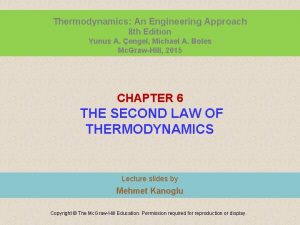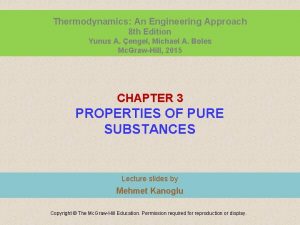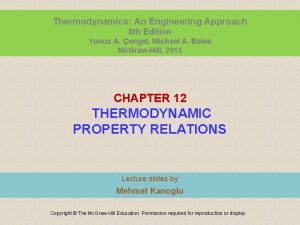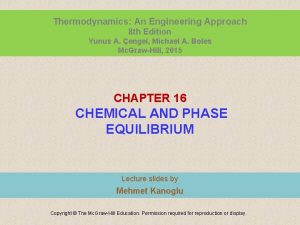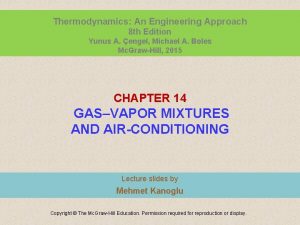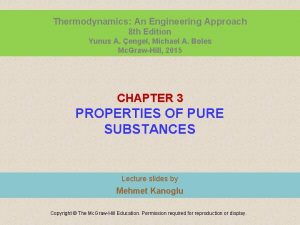Thermodynamics An Engineering Approach 8 th Edition Yunus

















































- Slides: 49

Thermodynamics: An Engineering Approach 8 th Edition Yunus A. Çengel, Michael A. Boles Mc. Graw-Hill, 2015 CHAPTER 2 ENERGY, ENERGY TRANSFER, AND GENERAL ENERGY ANALYSIS Lecture slides by Mehmet Kanoglu Copyright © The Mc. Graw-Hill Education. Permission required for reproduction or display.

Objectives • Introduce the concept of energy and define its various forms. • Discuss the nature of internal energy. • Define the concept of heat and the terminology associated with energy transfer by heat. • Discuss the three mechanisms of heat transfer: conduction, convection, and radiation. • Define the concept of work, including electrical work and several forms of mechanical work. • Introduce the first law of thermodynamics, energy balances, and mechanisms of energy transfer to or from a system. • Determine that a fluid flowing across a control surface of a control volume carries energy across the control surface in addition to any energy transfer across the control surface that may be in the form of heat and/or work. • Define energy conversion efficiencies. • Discuss the implications of energy conversion on the environment. 2

INTRODUCTION • • If we take the entire room—including the air and the refrigerator (or fan)—as the system, which is an adiabatic closed system since the room is well-sealed and well-insulated, the only energy interaction involved is the electrical energy crossing the system boundary and entering the room. As a result of the conversion of electric energy consumed by the device to heat, the room temperature will rise. A fan running in a well-sealed and well -insulated room will raise the temperature of air in the room. A refrigerator operating with its door open in a wellsealed and wellinsulated room 3

FORMS OF ENERGY • Energy can exist in numerous forms such as thermal, mechanical, kinetic, potential, electric, magnetic, chemical, and nuclear, and their sum constitutes the total energy, E of a system. • Thermodynamics deals only with the change of the total energy. • Macroscopic forms of energy: Those a system possesses as a whole with respect to some outside reference frame, such as kinetic and potential energies. • Microscopic forms of energy: Those related to the molecular structure of a system and the degree of the molecular activity. • Internal energy, U: The sum of all the microscopic forms of energy. • Kinetic energy, KE: The energy that a system possesses as a result of its motion relative to some reference frame. • Potential energy, PE: The energy that a system possesses as a result of its elevation in a gravitational field. 4

5

Kinetic energy per unit mass Potential energy per unit mass Mass flow rate Energy flow rate Total energy of a system Energy of a system per unit mass Total energy per unit mass 6

7

Some Physical Insight to Internal Energy Sensible energy: The portion of the internal energy of a system associated with the kinetic energies of the molecules. Latent energy: The internal energy associated with the phase of a system. Chemical energy: The internal energy associated with the atomic bonds in a molecule. Nuclear energy: The tremendous amount of energy associated with the strong bonds within the nucleus of the atom itself. Thermal = Sensible + Latent Internal = Sensible + Latent + Chemical + Nuclear 8

• The total energy of a system, can be contained or stored in a system, and thus can be viewed as the static forms of energy. • The forms of energy not stored in a system can be viewed as the dynamic forms of energy or as energy interactions. • The dynamic forms of energy are recognized at the system boundary as they cross it, and they represent the energy gained or lost by a system during a process. • The only two forms of energy interactions associated with a closed system are heat transfer and work. • The difference between heat transfer and work: An energy interaction is heat transfer if its driving force is a temperature difference. Otherwise it is work. 9

More on Nuclear Energy • The best known fission reaction involves the split of the uranium atom (the U-235 isotope) into other elements and is commonly used to generate electricity in nuclear power plants (440 of them in 2004, generating 363, 000 MW worldwide), to power nuclear submarines and aircraft carriers, and even to power spacecraft as well as building nuclear bombs. • Nuclear energy by fusion is released when two small nuclei combine into a larger one. • The uncontrolled fusion reaction was achieved in the early 1950 s, but all the efforts since then to achieve controlled fusion by massive lasers, powerful magnetic fields, and electric currents to generate power have failed. 10

Mechanical Energy Mechanical energy: The form of energy that can be converted to mechanical work completely and directly by an ideal mechanical device such as an ideal turbine. Kinetic and potential energies: The familiar forms of mechanical energy. Mechanical energy of a flowing fluid per unit mass Rate of mechanical energy of a flowing fluid Mechanical energy change of a fluid during incompressible flow per unit mass Rate of mechanical energy change of a fluid during incompressible flow 11

12

13

ENERGY TRANSFER BY HEAT Heat: The form of energy that is transferred between two systems (or a system and its surroundings) by virtue of a temperature difference. 14

Heat transfer per unit mass Amount of heat transfer when heat transfer rate is constant Amount of heat transfer when heat transfer rate changes with time 15

Historical Background on Heat • • Kinetic theory: Treats molecules as tiny balls that are in motion and thus possess kinetic energy. Heat: The energy associated with the random motion of atoms and molecules. Heat transfer mechanisms: • • • Conduction: The transfer of energy from the more energetic particles of a substance to the adjacent less energetic ones as a result of interaction between particles. Convection: The transfer of energy between a solid surface and the adjacent fluid that is in motion, and it involves the combined effects of conduction and fluid motion. Radiation: The transfer of energy due to the emission of electromagnetic waves (or photons). 16

ENERGY TRANSFER BY WORK • • • Work: The energy transfer associated with a force acting through a distance. ü A rising piston, a rotating shaft, and an electric wire crossing the system boundaries are all associated with work interactions Formal sign convention: Heat transfer to a system and work done by a system are positive; heat transfer from a system and work done on a system are negative. Alternative to sign convention is to use the subscripts in and out to indicate direction. This is the primary approach in this text. Work done per unit mass 17

Heat vs. Work • • • Both are recognized at the boundaries of a system as they cross the boundaries. That is, both heat and work are boundary phenomena. Systems possess energy, but not heat or work. Both are associated with a process, not a state. Unlike properties, heat or work has no meaning at a state. Both are path functions (i. e. , their magnitudes depend on the path followed during a process as well as the end states). Properties are point functions have exact differentials (d ). Path functions have inexact differentials ( ) 18

Electrical Work Electrical work Electrical power When potential difference and current change with time When potential difference and current remain constant 19

MECHANICAL FORMS OF WORK • There are two requirements for a work interaction between a system and its surroundings to exist: ü there must be a force acting on the boundary. ü the boundary must move. Work = Force Distance When force is not constant 20

A force F acting through a moment arm r generates a torque T Shaft Work This force acts through a distance s Shaft work The power transmitted through the shaft is the shaft work done per unit time 21

Spring Work When the length of the spring changes by a differential amount dx under the influence of a force F, the work done is Substituting and integrating yield For linear elastic springs, the displacement x is proportional to the force applied x 1 and x 2: the initial and the final displacements k: spring constant (k. N/m) 22

Work Associated with the Stretching of a Liquid Film Work Done on Elastic Solid Bars 23

Work Done to Raise or to Accelerate a Body 1. The work transfer needed to raise a body is equal to the change in the potential energy of the body. 2. The work transfer needed to accelerate a body is equal to the change in the kinetic energy of the body. Nonmechanical Forms of Work Electrical work: The generalized force is the voltage (the electrical potential) and the generalized displacement is the electrical charge. Magnetic work: The generalized force is the magnetic field strength and the generalized displacement is the total magnetic dipole moment. Electrical polarization work: The generalized force is the electric field strength and the generalized displacement is the polarization of the medium. 24

THE FIRST LAW OF THERMODYNAMICS • The first law of thermodynamics (the conservation of energy principle) provides a sound basis for studying the relationships among the various forms of energy and energy interactions. • The first law states that energy can be neither created nor destroyed during a process; it can only change forms. The First Law: For all adiabatic processes between two specified states of a closed system, the net work done is the same regardless of the nature of the closed system and the details of the process. 25

26

27

Energy Balance The net change (increase or decrease) in the total energy of the system during a process is equal to the difference between the total energy entering and the total energy leaving the system during that process. 28

Energy Change of a System, Esystem Internal, kinetic, and potential energy changes 29

Mechanisms of Energy Transfer, Ein and Eout 30

Mechanisms of energy transfer: • Heat transfer • Work transfer • Mass flow A closed mass involves only heat transfer and work. 31

ENERGY CONVERSION EFFICIENCIES Efficiency is one of the most frequently used terms in thermodynamics, and it indicates how well an energy conversion or transfer process is accomplished. Efficiency of a water heater: The ratio of the energy delivered to the house by hot water to the energy supplied to the water heater. 32

Heating value of the fuel: The amount of heat released when a unit amount of fuel at room temperature is completely burned and the combustion products are cooled to the room temperature. Lower heating value (LHV): When the water leaves as a vapor. Higher heating value (HHV): When the water in the combustion gases is completely condensed and thus the heat of vaporization is also recovered. The efficiency of space heating systems of residential and commercial buildings is usually expressed in terms of the annual fuel utilization efficiency (AFUE), which accounts for the combustion efficiency as well as other losses such as heat losses to unheated areas and start-up and cooldown losses. 33

Overall efficiency of a power plant • Generator: A device that converts mechanical energy to electrical energy. • Generator efficiency: The ratio of the electrical power output to the mechanical power input. • Thermal efficiency of a power plant: The ratio of the net electrical power output to the rate of fuel energy input. 34

Lighting efficacy: The amount of light output in lumens per W of electricity consumed. 35

• Using energy-efficient appliances conserve energy. • It helps the environment by reducing the amount of pollutants emitted to the atmosphere during the combustion of fuel. • The combustion of fuel produces • carbon dioxide, causes global warming • nitrogen oxides and hydrocarbons, cause smog • carbon monoxide, toxic • sulfur dioxide, causes acid rain. 36

37

Efficiencies of Mechanical and Electrical Devices Mechanical efficiency The effectiveness of the conversion process between the mechanical work supplied or extracted and the mechanical energy of the fluid is expressed by the pump efficiency and turbine efficiency, 38

Pump efficiency Generator efficiency Pump-Motor overall efficiency Turbine-Generator overall efficiency 39

ENERGY AND ENVIRONMENT • The conversion of energy from one form to another often affects the environment and the air we breathe in many ways, and thus the study of energy is not complete without considering its impact on the environment. • Pollutants emitted during the combustion of fossil fuels are responsible for smog, acid rain, and global warming. • The environmental pollution has reached such high levels that it became a serious threat to vegetation, wild life, and human health. 40

41

Ozone and Smog • Smog: Made up mostly of ground-level ozone (O 3), but it also contains numerous other chemicals, including carbon monoxide (CO), particulate matter such as soot and dust, volatile organic compounds (VOCs) such as benzene, butane, and other hydrocarbons. • Hydrocarbons and nitrogen oxides react in the presence of sunlight on hot calm days to form ground-level ozone. • Ozone irritates eyes and damages the air sacs in the lungs where oxygen and carbon dioxide are exchanged, causing eventual hardening of this soft and spongy tissue. • It also causes shortness of breath, wheezing, fatigue, headaches, and nausea, and aggravates respiratory problems such as asthma. • The other serious pollutant in smog is carbon monoxide, which is a colorless, odorless, poisonous gas. • • It is mostly emitted by motor vehicles. • Suspended particulate matter such as dust and soot are emitted by vehicles and industrial facilities. Such particles irritate the eyes and the lungs. It deprives the body’s organs from getting enough oxygen by binding with the red blood cells that would otherwise carry oxygen. It is fatal at high levels. 42

43

Acid Rain • The sulfur in the fuel reacts with oxygen to form sulfur dioxide (SO 2), which is an air pollutant. • The main source of SO 2 is the electric power plants that burn high-sulfur coal. • Motor vehicles also contribute to SO 2 emissions since gasoline and diesel fuel also contain small amounts of sulfur. • The sulfur oxides and nitric oxides react with water vapor and other chemicals high in the atmosphere in the presence of sunlight to form sulfuric and nitric acids. • The acids formed usually dissolve in the suspended water droplets in clouds or fog. • These acid-laden droplets, which can be as acidic as lemon juice, are washed from the air on to the soil by rain or snow. This is known as acid rain. 44

45

The Greenhouse Effect: Global Warming and Climate Change • CO 2 is produced by the burning of fossil fuels such as coal, oil, and natural gas. • Greenhouse effect: Glass allows the solar radiation to enter freely but blocks the infrared radiation emitted by the interior surfaces. This causes a rise in the interior temperature as a result of thermal energy buildup in a space (i. e. , car). • The surface of the earth, which warms up during the day as a result of the absorption of solar energy, cools down at night by radiating part of its energy into deep space as infrared radiation. • Carbon dioxide (CO 2), water vapor, and trace amounts of some other gases such as methane and nitrogen oxides act like a blanket and keep the earth warm at night by blocking the heat radiated from the earth. The result is global warming. • These gases are called “greenhouse gases, ” with CO 2 being the primary component. 46

• A 1995 report: The earth has already warmed about 0. 5°C during the last century, and they estimate that the earth’s temperature will rise another 2°C by the year 2100. • A rise of this magnitude can cause severe changes in weather patterns with storms and heavy rains and flooding at some parts and drought in others, major floods due to the melting of ice at the poles, loss of wetlands and coastal areas due to rising sea levels, and other negative results. • Improved energy efficiency, • energy conservation, • using renewable energy sources • help minimize global warming. 47

48

Summary • Forms of energy ü Macroscopic = kinetic + potential ü Microscopic = Internal energy (sensible + latent + chemical + nuclear) • • Energy transfer by heat Energy transfer by work Mechanical forms of work The first law of thermodynamics ü Energy balance ü Energy change of a system ü Mechanisms of energy transfer (heat, work, mass flow) • Energy conversion efficiencies ü Efficiencies of mechanical and electrical devices (turbines, pumps) • Energy and environment ü Ozone and smog ü Acid rain ü The Greenhouse effect: Global warming and climate change 49
 Feedwater
Feedwater Thermodynamics an engineering approach
Thermodynamics an engineering approach Thermodynamics an engineering approach
Thermodynamics an engineering approach Yunus emrenin hayatı slayt
Yunus emrenin hayatı slayt Yunus triyonggo
Yunus triyonggo Hazrat yunus
Hazrat yunus Dr kamran yunus
Dr kamran yunus Musammat gazel örneği
Musammat gazel örneği Why was prophet yunus punished
Why was prophet yunus punished Yunus hacettepe
Yunus hacettepe Hukum tajwid minhum
Hukum tajwid minhum Mukhlis yunus
Mukhlis yunus Peta konsep tentang iman kepada kitab kitab allah
Peta konsep tentang iman kepada kitab kitab allah Diagrama tv termodinamica
Diagrama tv termodinamica Surah yunus for diabetes
Surah yunus for diabetes Yunus cengel
Yunus cengel Conceptos de transferencia de calor
Conceptos de transferencia de calor Yunus.hacettepe
Yunus.hacettepe Emre erkovan
Emre erkovan Yunus programlama dili
Yunus programlama dili Yunus aksoy
Yunus aksoy Heather must prove this theorem
Heather must prove this theorem Engineering thermodynamics
Engineering thermodynamics Chapter 6
Chapter 6 Chemical engineering thermodynamics 8th solution chapter 3
Chemical engineering thermodynamics 8th solution chapter 3 Chemical engineering thermodynamics 8th solution chapter 4
Chemical engineering thermodynamics 8th solution chapter 4 Chapter 6
Chapter 6 Thermodynamics chapter 2
Thermodynamics chapter 2 Chemical engineering thermodynamics 8th solution chapter 10
Chemical engineering thermodynamics 8th solution chapter 10 Chemical engineering thermodynamics 8th solution chapter 10
Chemical engineering thermodynamics 8th solution chapter 10 Using mis (10th edition) 10th edition
Using mis (10th edition) 10th edition Report
Report Computer architecture 5th edition
Computer architecture 5th edition Computer architecture a quantitative approach sixth edition
Computer architecture a quantitative approach sixth edition Transductive reasoning psychology
Transductive reasoning psychology Computer architecture a quantitative approach sixth edition
Computer architecture a quantitative approach sixth edition Fifth edition chemistry a molecular approach
Fifth edition chemistry a molecular approach Computer architecture a quantitative approach sixth edition
Computer architecture a quantitative approach sixth edition Traffic and highway engineering 4th edition
Traffic and highway engineering 4th edition Engineering economy 15th edition
Engineering economy 15th edition Engineering economy 16th edition solution manual chapter 5
Engineering economy 16th edition solution manual chapter 5 Engineering economy 16th edition chapter 4 solutions
Engineering economy 16th edition chapter 4 solutions Develop the alternatives engineering economy
Develop the alternatives engineering economy Engineering economy 16th edition solution manual chapter 5
Engineering economy 16th edition solution manual chapter 5 Engineering economy 16th edition chapter 3 solutions
Engineering economy 16th edition chapter 3 solutions Cost concepts and design economics
Cost concepts and design economics Sketch chapter 15
Sketch chapter 15 Engineering mechanics (9th) edition chapter 12 problem 30p
Engineering mechanics (9th) edition chapter 12 problem 30p Engineering economy 16th edition chapter 1 solutions
Engineering economy 16th edition chapter 1 solutions Engineering drawing and design 7th edition
Engineering drawing and design 7th edition
